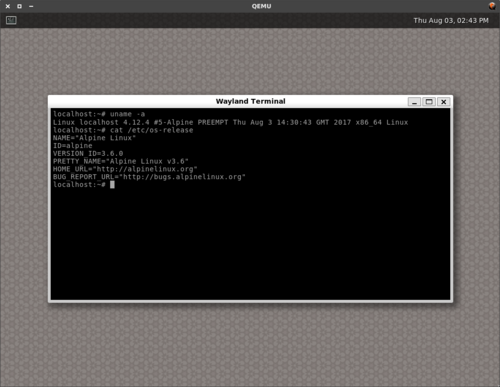QEMU amd64 (qemu-amd64)
 QEMU running Phosh | |
| Manufacturer | QEMU |
|---|---|
| Name | amd64 |
| Codename | qemu-amd64 |
| Released | 2003 |
| Hardware | |
| Chipset | QEMU Standard PC |
| CPU | QEMU Virtual |
| GPU | Virgil 3D |
| Architecture | x86_64 |
| Software | |
| Original software | none |
| postmarketOS | |
| Category | main |
| Pre-built images | yes |
| postmarketOS kernel | 5.10 (LTS) |
| Internal storage |
No data |
|---|---|
| SD card |
No data |
| Screen |
Works |
| Multimedia | |
| 3D Acceleration |
Works |
| Audio |
Works |
| Camera Flash |
No data |
| Miscellaneous | |
| FDE |
Works |
| HDMI/DP |
No data |
| Sensors | |
| Magnetometer |
No data |
| Ambient Light |
No data |
| Proximity |
No data |
| Hall Effect |
No data |
| Haptics |
No data |
| Barometer |
No data |
This device is used for testing purposes. It is possible to run postmarketOS in a x86_64 Virtual Machine.
Contributors
- ollieparanoid
- MartijnBraam
- Minecrell
- drebrez
Usage
First, install pmbootstrap.
$ pmbootstrap init # Choose device "qemu-amd64"
$ pmbootstrap install
$ pmbootstrap qemu
See pmbootstrap qemu --help for more options. For example the default memory allocation is only 1024, which may not be enough for modern desktop environments.
Network
Qemu's user mode network stack is used. With all UIs except for none, postmarketOS should run a DHCP client on boot that automatically connects to QEMU's DNS server and as a result you should have network available. Note that ICMP (ping) may not work depending on your host (see QEMU's documentation for details).
If you selected none as user interface and don't have network, do one of the following:
a) Select the UI console instead. It is slightly bigger and will automatically start a DHCP client.
b) Use pmbootstrap install --add=networkmanager.
c) Run Alpine's setup tools in the TTY prompt to generate a /etc/network/interfaces file for ifupdown-ng and bring up eth0 manually:
$ sudo setup-interfaces
$ sudo ifup eth0
Audio
Audio is disabled by default. To enable audio, select an audio backend (usually pa for PulseAudio or alsa for ALSA), and pass:
$ pmbootstrap qemu --audio pa
Rootfs location
You could find postmarketOS rootfs image at ~/.local/var/pmbootstrap/chroot_native/home/pmos/rootfs .
What works
- Storage
- Network
- Keyboard and mouse
- Graphical interfaces (Weston, Plasma Mobile, ...)
osk-sdl- Audio
Screenshots
- QEMU running weston
- QEMU running Plasma Mobile

